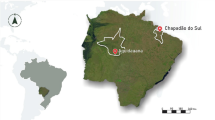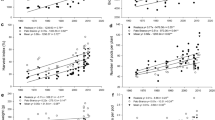Summary
Three maturity groups of soybeans (Glycine max L.) were used to investigate the relationship between dry-matter accumulation (DMA) and grain yield (GY), and the prospects for selection of high seed yielding strains among the existing soybean cultivars in a tropical environment. The positive and significant association between DMA and GY (r=0.888***) indicated that selection for high DMA could give gains in GY. However, the higher harvest index (HI=37.5%) for the low seed yielding early maturing genotypes than the more vegetatively endowed and higher seed producing late maturity group, is an indication that excessive DMA could be disadvantageous. Total seed yield per land area for the three maturity groups of soybeans showed that the genotypes with high harvest index and low seed yield could be as good as those ones with high seed and dry-matter yields with low harvest index. The high coefficient of variation which ranged between 18.1 and 59.8% and the heritability estimations which also ranged from 34.4 to 82.2% are indicative of the presence of substantial genetic diversity and there are good prospects for the improvement of the crop through selection.
Similar content being viewed by others
References
Allard, R.W., 1960. Principles of Plant Breeding, New York, London: John Wiley and Sons Inc. pp 83–88.
Buzzell, R.I. & B.R., Buttery, 1977. Soybean harvest index in hill-plots. Crop Science 17: 968–970.
Cooper, C.S., 1977. Growth of the legume seedling. Adv. Agron. 29: 119–139.
Donald, C.M. & J., Hamblin, 1976. The biological yield and harvest index of cereals as agronomic and plant breeding criteria. Advances in Agronomy 28: 361–405.
Fakorede, M.A.B. & D.K., Ojo, 1981. Variability for seedling vigour in maize. Expl. Agric. 17: 195–201.
Faluyi, M.A., 1986. Investigations on seedling vigour in cashew (Anacardium occidentale L.). Plant Breeding 97: 237–245.
Faluyi, M.A., 1987a. Preliminary studies on the improvement of soybeans in a tropical rainforest environment. Nig. J. Pure and Appl. Sci. 2: 23–29.
Faluyi, M.A., 1987b. Growth patterns and effects of root nodules on vigour and grain yield of soybeans in a tropical rainforest location. Nigerian Journal of Agronomy 2: 70–76.
Goldy, R.G., 1988. Variation in some yield determining components in muscadine grapes and their correlation to yield. Euphytica 39: 39–42.
Jain, H.K., 1986. Eighty years of post-mendelian breeding for crop yield: nature of selection pressures and future potential. Indian Journal of Genetics 46: 30–53.
Lawn, R.J., 1989. Agronomic and physiological constraint to the productivity of tropical grain legumes and prospects for improvement. Expl. Agric. 25: 509–528.
Williams, W., 1979. Studies on the development of lupins for oil and protein. Euphytica 28: 481–488.
Author information
Authors and Affiliations
Rights and permissions
About this article
Cite this article
Faluyi, M.A. Implications of selecting improved strains of soybeans for dry-matter accumulation and grain yield. Euphytica 50, 197–201 (1990). https://doi.org/10.1007/BF00023645
Received:
Accepted:
Issue Date:
DOI: https://doi.org/10.1007/BF00023645




